Hydrogen, hydrogen everywhere...
- Published
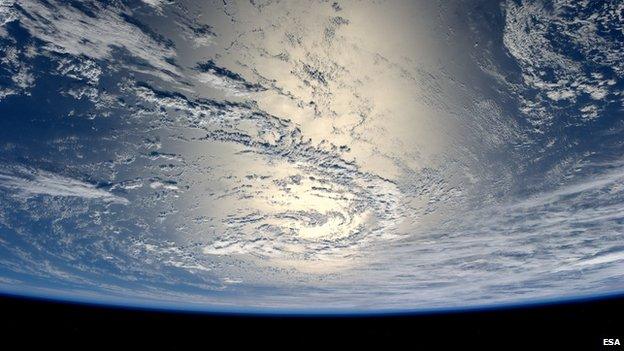
Hydrogen is most commonly found in water - H2O - and in fossil fuels
Hydrogen is the most abundant element in the universe. And when you burn it or use it to produce electricity, the only waste product is water.
In the era of global warming, it would seem to be the perfect fuel.
So why aren't we all driving round in hydrogen-powered cars, moving our goods in hydrogen-powered lorries, and heating our homes and offices with this wonder element?
In short, fossil fuels got there first.
Oil, coal and gas were easily accessible and powered the industrial revolution. Around them, entire economies and transport infrastructures were built.
It was only much later that we realised the potentially catastrophic effects hydrocarbon waste products could have on the environment.
"In the Seventies, the oil crisis made people realise that oil-based economies were vulnerable, so people started to get excited about the potential for the hydrogen economy," says Alex Hart, hydrogen expert at the Carbon Trust.
"But then climate change saw a push towards electricity as the answer to hydrocarbons and hydrogen seemed like a distraction."
Now hydrogen is staging something of a comeback.
Fuel cell tech
Hydrogen fuel cells have been around for decades, but they have always been heavy and expensive.
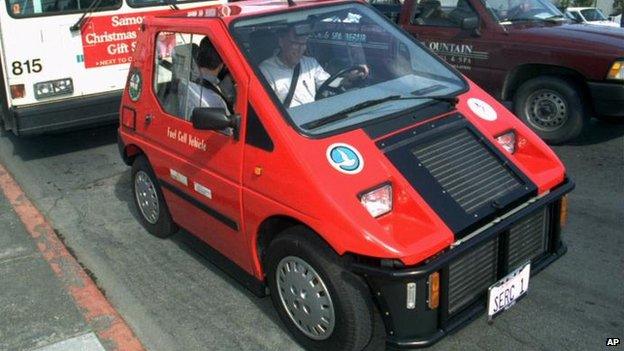
1998: Peter Lehman, Schatz Energy Research Center, driving the first US road-legal hydrogen fuel cell car

Toyota's Mirai hydrogen fuel cell car will cost about €66,000 (£47,000)
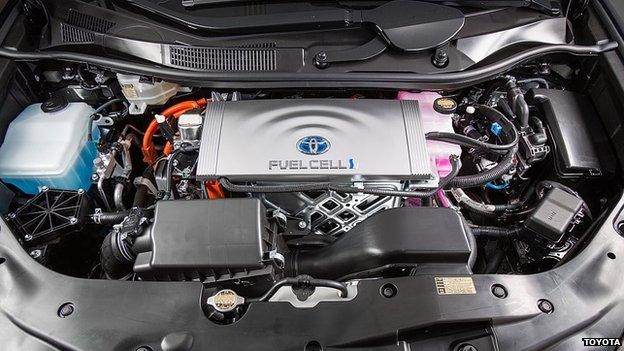
Fuel cells are now smaller, cheaper and more efficient
Now Japanese car manufacturers in particular, like Honda, Toyota and Nissan, as well as Korea's Hyundai, believe they have finally made the fuel cell commercially viable and much more efficient.
Toyota's Mirai fuel cell electric vehicle (FCEV), for example, is being rolled out in the US, Japan, Denmark, Germany and the UK this year.
With a range of about 300-400 miles (480-640km) and a tank that can be filled in a matter of minutes, Toyota is hoping FCEVs can give conventional electric vehicles (EVs) a run for their money.

How does a hydrogen fuel cell work?
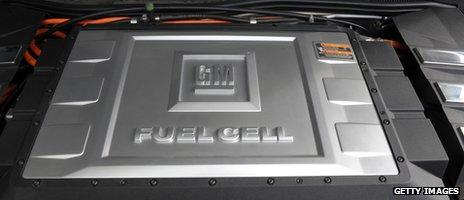
A fuel cell is composed of an anode, a cathode and an electrolyte membrane. Hydrogen is passed through the anode and oxygen through the cathode. At the anode, the hydrogen molecules are split into electrons and protons.
The protons pass through the electrolyte membrane, while the electrons are driven through a circuit, generating an electric current and heat. At the cathode, the protons, electrons and oxygen combine to produce water molecules.
Fuel cells are clean - the only by-products are electricity, heat and water - and they are quiet, because they have no moving parts.
The proton exchange membrane fuel cell is currently the most suitable for vehicles because it can operate at lower temperatures than other fuel cells, but it is not the most efficient.

"In Japan we have a three-year waiting list for the car - demand is outstripping supply," says Toyota's Nik Pearson.
Earlier this year, Toyota announced that it would share nearly 6,000 of its hydrogen fuel cell patents in a bid to boost FCEV development.
The patent portfolio covers fuel cell stacks, high-pressure hydrogen tanks, software control systems and the industrial processes involved in generating and supplying the gas.
Pump priming
But will all the other manufacturers develop FCEVs - and consumers buy them - without a filling station network already in place?
"There are already 100 hydrogen stations in California," says Mr Pearson, "and in the UK the government has given £11m of backing for a small network of 15 stations in the South East."
This is still small beer compared to the hundreds of thousands of petrol and diesel stations worldwide.
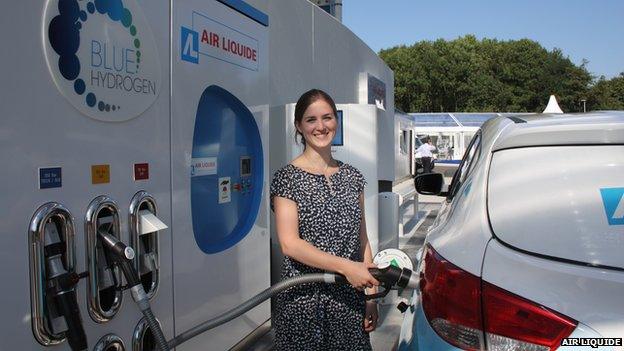
Hydrogen cars can be refuelled in a matter of minutes, whereas electric battery vehicles take hours to recharge
"The technology of HFCEV has come on in leaps and bounds," says Dr Hamish Nichol, innovation manager for hydrogen at industrial gases giant BOC, part of the Linde Group. "But you need the infrastructure to fuel those cars - it's a chicken and egg situation.
"We're a commercial business - we're not going to build a hydrogen network just for the good of mankind. So we're going to need subsidy from the government."

Industrial gases companies, energy companies, vehicle manufacturers and governments are beginning to realise that they have to work together to build the infrastructure, otherwise each stakeholder will be waiting for the other to make the first move.
For example, in Germany just such a consortium - H2 Mobility - is building 100 hydrogen stations over the next two years, with a target of 400 by 2023. The project will cost about €350m (£250m).
And in the north-east of the US, Air Liquide is co-operating with Toyota to build 12 filling stations as a way of boosting interest in hydrogen cars.
But building a comprehensive network will cost billions, experts believe.
Grey or green?
Hydrogen may be a fuel with water as the only waste product, but producing it - most commonly by "cracking" hydrocarbons such as methane - uses a lot of energy and creates greenhouse gases as by-products.
"One of the reasons for using hydrogen is to reduce the carbon footprint, so splitting methane leaves you with the problem of what to do with the CO2 produced," says Dr Nichol.
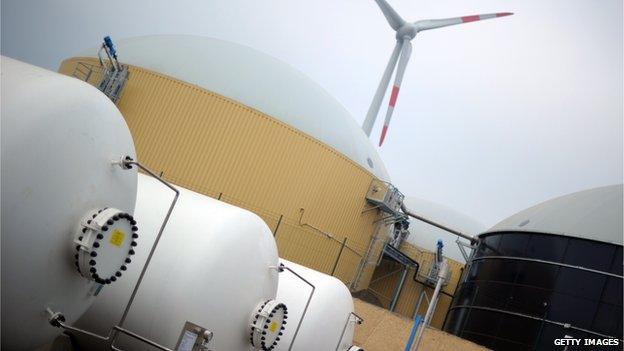
This German power station can produce electricity, heat and hydrogen from renewable energy sources
This industrially produced "grey hydrogen" currently accounts for about 95% of total production, says Pierre-Etienne Franc, head of advanced business and technology for Air Liquide, another big industrial gases company.
Far more eco-friendly is hydrogen produced through electrolysis - splitting water into its constituent hydrogen and oxygen molecules - particularly if the electricity used has come from renewable sources, such as wind and solar.
This is the ideal zero-carbon solution.

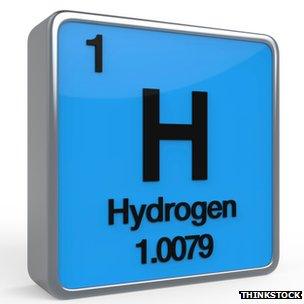
Hydrogen facts
Hydrogen is the first, lightest and simplest element in the periodic table
It is the most abundant element in the universe
Most of the hydrogen on earth exists in the form of water and organic compounds
The sun converts hydrogen into helium, producing vast amounts of energy
Hydrogen reacts explosively with oxygen, chlorine and fluorine
Henry Cavendish discovered hydrogen, or "inflammable air" as he called it, in the 18th Century
Hydrogen means "water producing"

Another big advantage of electrolysis is that it allows hydrogen to be produced on site, cutting out distribution costs.
Denmark already has five hydrogen filling stations with embedded electrolysers, and Aberdeen City Council recently opened the UK's largest hydrogen production and bus refuelling station, owned and operated by BOC.
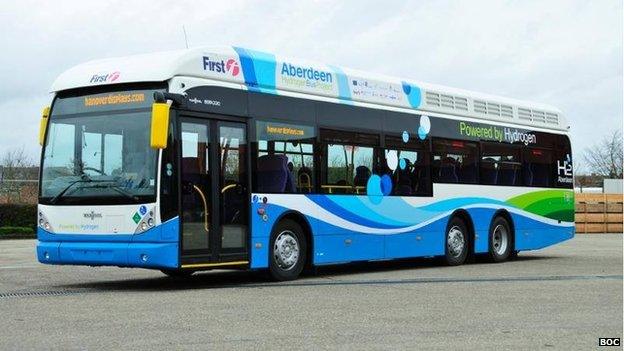
Aberdeen is now home to Europe's largest hydrogen bus fleet
The station will fuel 10 hydrogen fuel cell buses.
"But [electrolysis] is about 10 times more expensive than industrial production," admits Mr Franc.
These costs could come down if night-time wind power electricity were used to produce hydrogen when domestic demand is at its lowest, he argues. Oil companies like Shell are currently exploring this option.
Hydrogen future?
So are we well on the road to a fully-fledged hydrogen economy, weaned off our dependence on damaging hydrocarbons?
Possibly, but most industry experts believe that road will be a long one.
"It's going to take a long time because you're completely changing the paradigm - the infrastructure, the regulations - everything," says Mr Franc. "We're on a journey, but we can't go too fast."
The Carbon Trust's Alex Hart is similarly cautious: "Vehicles will definitely be fuelled differently in future, but whether by hydrogen, electricity or biofuel is less clear. We just don't know what the dominant technology will be.
"But we will decarbonise our world - we have to."